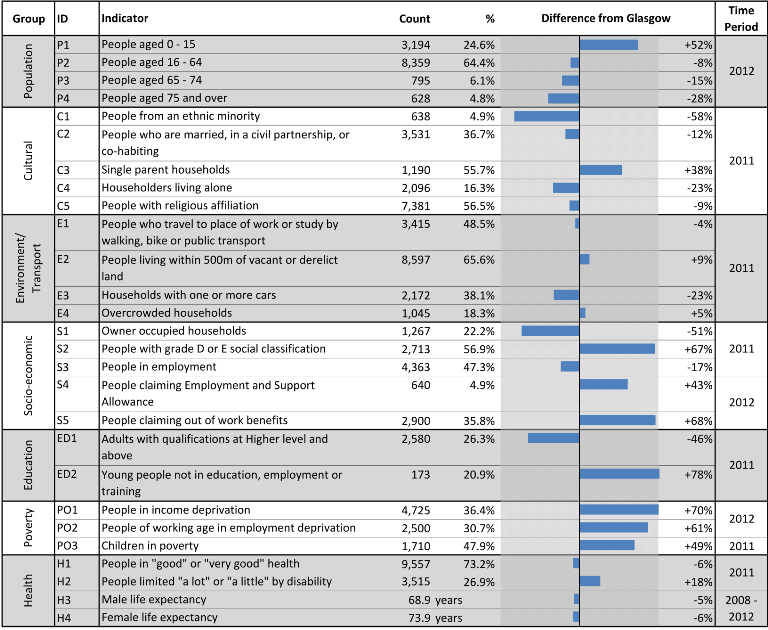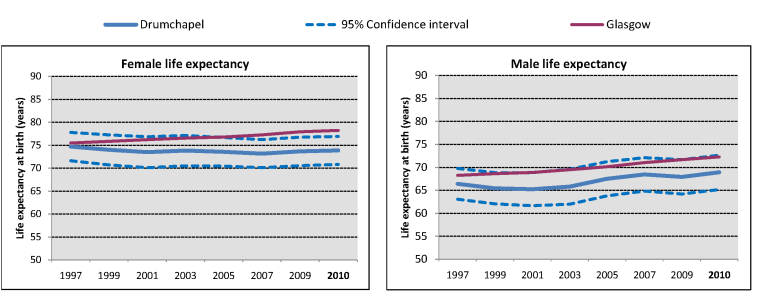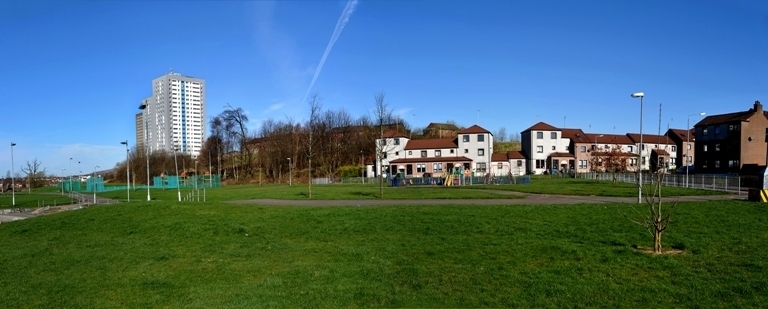Drumchapel
*Please note that this profile is based on data from the 2011 Census.*
A printer friendly version of this sector profile can be downloaded here
Drumchapel is a neighbourhood in the north west of Glasgow with a population of 12,976.
Neighbhourhood comparisons with Glasgow
Women in Drumchapel live, on average, five years longer than men. The estimates of male and female life expectancy are slightly lower than the Glasgow average. Drumchapel has a very high proportion of children (25% of the population) and one of the highest rates of child poverty (48%) in Glasgow. Single-parent households make up 56% of all households with dependent children. The neighbourhood has a relatively low employment rate.
 Neighbourhood trends
Neighbourhood trends
 Estimated female life expectancy reduced slightly in the period between 1996 and 2010. Life expectancy of males, on the other hand, increased slightly. Estimates of male and female life expectancy were lower than the Glasgow average throughout the period shown.
Estimated female life expectancy reduced slightly in the period between 1996 and 2010. Life expectancy of males, on the other hand, increased slightly. Estimates of male and female life expectancy were lower than the Glasgow average throughout the period shown. The overall population in Drumchapel decreased by 22% between 1996 and 2012. The population size decreased across all age groups. The percentage of the total neighbourhood population from a minority ethnic group increased from 1% in 2001 to 5% in 2011. The percentage of the population from an ethnic minority group remained considerably lower than the Glasgow average between 2001 and 2011.
The overall population in Drumchapel decreased by 22% between 1996 and 2012. The population size decreased across all age groups. The percentage of the total neighbourhood population from a minority ethnic group increased from 1% in 2001 to 5% in 2011. The percentage of the population from an ethnic minority group remained considerably lower than the Glasgow average between 2001 and 2011.
Notes
A document giving detailed notes and definitions for the information presented in this profile can be downloaded here.
An Excel workbook containing the data used in all of the profiles can be downloaded here. This workbook also includes alternative output formats and further breakdowns of some of the variables.
1. Data sources: Scottish Index of Multiple Deprivation (SIMD) 2012, Census 2011, Census 2001, HMRC, NOMIS, National Records of Scotland (NRS) and Scottish Government.
2. Populations presented in the population trend chart and used to calculate life expectancy estimates are taken from NRS small area population estimates and are based on: the 2001 Census for the years 1996-2001; both the 2001 and 2011 Census for the years 2002-2010; and the 2011 Census for the years 2011-2012.
3. The Income deprivation and Employment deprivation indicators are derived from SIMD 2012, more information on this deprivation index can be found at: http://simd.scotland.gov.uk/publication-2012
4. Life expectancies are calculated based on population estimates and death registrations. 95% confidence intervals have been added on the graphs to give an indication of their accuracy. The x-axes of the life expectancy graphs give the mid-year for each life expectancy estimate, e.g. 2010 represents the life expectancy estimate for the period 2008-2012.
Glasgow City Council have also produced neighbourhood profiles based on data from the 2011 Census which can be accessed via this link.
